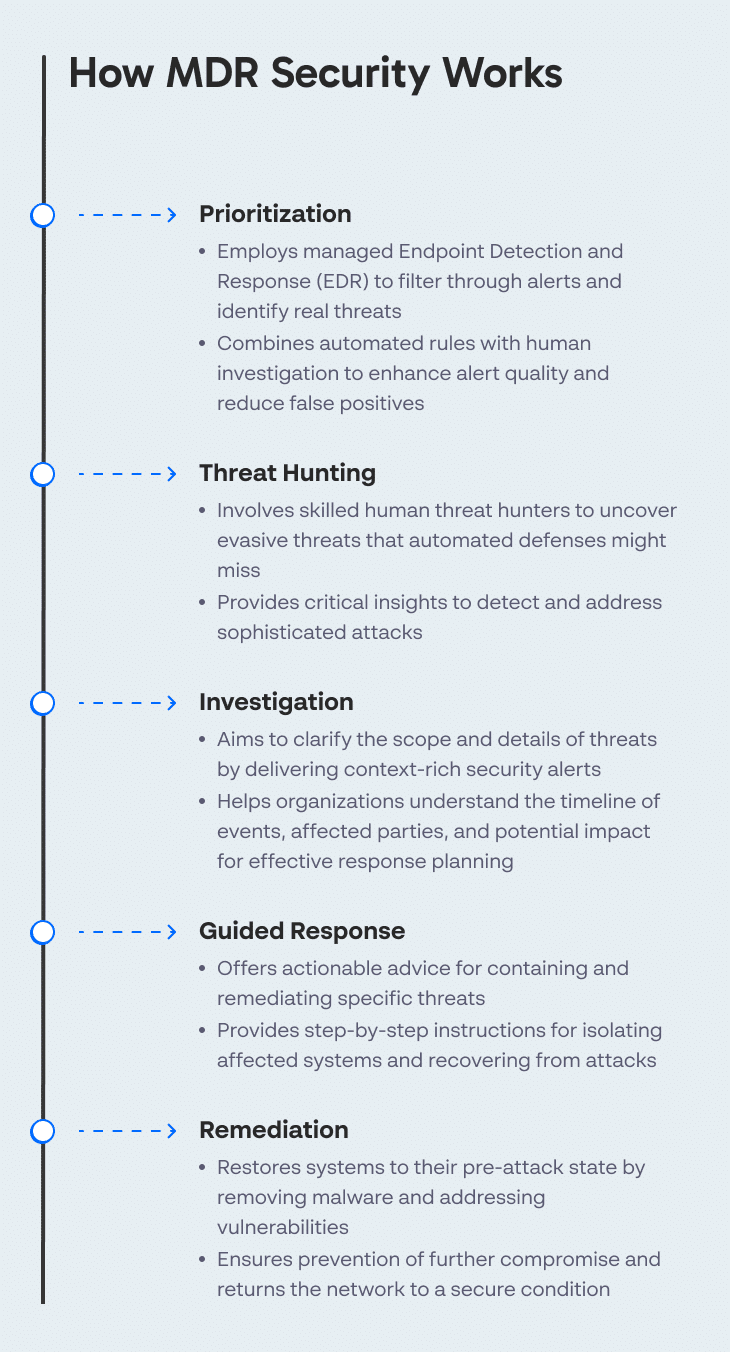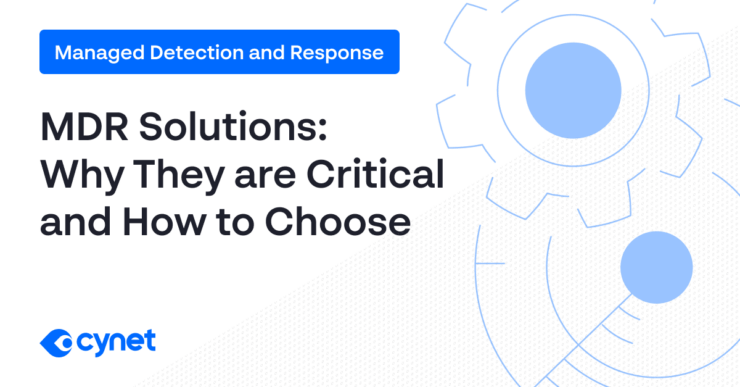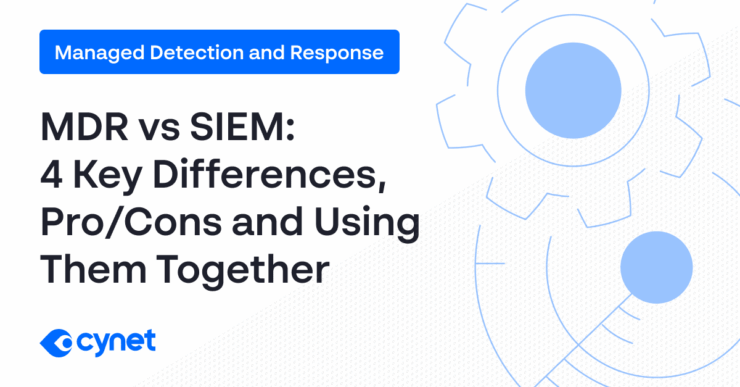Managed Detection and Response (MDR) is a managed 24/7 service that includes threat monitoring, detection and response. The goal of MDR is to assist enterprises with their incident response (IR) needs. It includes automated technologies which can be deployed at both the network and host layers. MDR employs threat intelligence and advanced analytics in combination with human incident investigation and response experts.
MDR providers offer a wide range of remote response services, including threat containment and support in bringing systems and networks back to normal operations. Its primary advantage is that it allows organizations to rapidly identify and mitigate threats without additional security staff.
4 Business Challenges MDR Services Solve
Most organizations face several challenges when trying to implement a comprehensive cybersecurity program. MDR offers services that help meet these challenges:
- Lack of internal security talent—the talent shortage in cybersecurity is making it difficult for organizations to find and keep qualified cybersecurity professionals. This effort is both challenging and costly, and organizations—even enterprises with large budgets—struggle to hire these experts, if they can afford to at all. MDR helps ensure that organizations can augment their security expertise and staff overnight.
- Advanced threat identification—sophisticated attacks such as advanced persistent threats (APTs) employ tools and techniques that help attackers remain undetected by most traditional security solutions. MDR providers can detect and remediate these threats by implementing proactive threat hunting.
- Underlying security flaws—bad practices can expose organizations to underlying security flaws. MDR services actively monitor the attack surface of the infrastructure and actively hunt for threats and previously unknown issues. MDR services help organizations identify these issues and provide guidance on how to remediate them.
- Alert fatigue—traditional security tools can generate an overwhelming amount of security alerts, including a large volume of false positives. This can lead to alert fatigue, in which security staff start to ignore many alerts. MDR services offer the technology and expertise required to efficiently review all relevant alerts, identify breaches and contain them before they do damage.
How MDR Security Works

Here are the core capabilities offered by MDR security services:
Prioritization
Managed prioritization, or managed Endpoint Detection and Response (EDR), can help organizations sift through massive volumes of alerts and determine which they should address first. Managed EDR services employ automated rules in combination with human investigation in order to distinguish false positives and benign events from real threats. Managed prioritization uses additional context to distill threats into high-quality alerts.
Threat Hunting
Human threat hunters have the skills and expertise needed to identify the most evasive threats. Threat hunters provide the insights needed to catch threats that automated defenses miss.
Investigation
The goal of managed investigation is to help organizations quickly understand the scope and details of threats. This is typically achieved by providing security alerts that contain additional context. Managed investigation services help organizations completely understand what happened and when, as well as who was affected and how far the attack could go. The information can help organizations plan an effective response.
Guided Response
The main purpose of guided response is to deliver actionable advice on how to best contain and remediate a certain threat. Guided response services provide advice on a wide range of security incidents. For example, advising to isolate an affected system from the corporate network, and providing step-by-step instructions on how to eliminate a threat or recover from the attack.
Remediation
Remediation is the final step performed during incident response. Managed remediation helps restore your system to its pre-attack state. It may involve cleaning a registry, removing malware, removing any persistence mechanisms, and ejecting intruders. Managed remediation helps prevent any additional compromise and return your network to a known good state.
Learn more in our detailed guide to MDR security.
The Main Benefits of MDR Services
Organizations that incorporate MDR services can enjoy multiple benefits that will strengthen their cybersecurity posture. Here are the main advantages:
- 24/7 Threat Monitoring and Incident Response – Continuous, round-the-clock surveillance of the corporate environment. This ensures threats are detected and responded to in real time, even outside regular business hours, reducing the attack window and the likelihood of business operation disruption.
- Expertise Without the Overhead – Access to highly skilled security analysts, threat hunters, and incident responders without the cost and effort of hiring, training, and retaining an in-house team. This is especially cost-effective given the global cybersecurity talent shortage and small organizations’ need to focus on their core business.
- Access to Advanced Technologies – Detection of CVEs and zero-days, by using behavioral analytics, threat intelligence, AI/ML, and the newest security tools. This ensures a hardened security posture for organizations based on the most recent tech and practices, which small businesses can’t afford to procure on their own.
- Scalability and Flexibility – Scalability based on business and technical needs. This includes business expansion, changes in the threat landscape, and digital transformation. This reduces overhead and ensures consistent security. As your organization grows or your threat landscape evolves, MDR services can scale with you. They can adapt to hybrid environments, integrate with cloud and on-prem infrastructure, and work across diverse endpoints and workloads.
- Compliance and Reporting Support – Helping organizations meet compliance requirements (like GDPR, HIPAA, or PCI-DSS) by offering detailed audit logs, incident reports, and documentation for regulators. This reduces the burden on internal departments, which small businesses can’t afford to de-focus from the core business.
What are the 4 Types of MDR Services?
When choosing an MDR service, organizations need to decide whether they want to use their own MDR stack or use the product stack offered by the provider. There are four main approaches to MDR services:
- Bring-your-own-stack (BYOS) – This model is suitable for organizations that understand their requirements (and regulatory obligations), and have their own stack. The MDR vendor must be able to work solely on the proprietary stack. This approach is common for organizations that want to keep the products they’ve already deployed, or that have to use specific tools for oversight or regulatory purposes.
- Vendor-built – this is a widely used model whereby a vendor layers in its MDR provisions over its own tools. This methodology generally achieves the greatest rewards for integration between products employed, as they are all from one vendor. However, this might also cause tight lock-in if your organization wishes to change service providers or products.
- Vendor-supplied – the MDR supplier makes use of software from trusted and known vendors that it then manages and implements on your behalf. This is suitable for organizations that are looking to change out their stack, or don’t have an established set of tools
- Hybrid – this combines both in-house and external software. Organizations often choose a vendor that supports an appropriate balance of proprietary and supplied/built MDR software. For example, they might use the vendor’s best-of-breed tools with their own customized software or tools they’ve already purchased licenses for.
Related content: learn more about vendor-built and vendor-supplied MDRs in our guide to MDR solutions
How Is MDR Better than Traditional MSSP?
Managed security service providers (MSSP) offer a basic level of cybersecurity monitoring and management, including antivirus, firewalls, intrusion detection, and management of virtual private networks (VPNs).
However, MSSPs typically do not handle incident response, containment and eradication of threats, or active threat hunting. Here are some of the key capabilities MDR provide beyond the basic MSSP offering:
Improved technology
MDR services incorporate the newest technologies in detection and response, including next-gen antivirus, machine learning, and AI-based automation. In contrast, MSS tends to rely on more traditional technologies and methods. Additionally, MDR cybersecurity services may be more accommodating of cloud services and hybrid systems than MSSPs.
Incident Response Expertise
MSSPs are generally not committed to providing a high level of security expertise or guidance. An MSSP typically offers Tier 1 SOC analysts who are focused on supporting automated protection and detection systems.
This is very different from MDR providers, who incorporate whole teams of security professionals of various levels. Rather than simply acting as responsive support staff, MDR professionals proactively monitor systems and take responsibility for threat containment and remediation.
Expanded Service Scope
A standard MSSP is only responsible for monitoring systems and forwarding alerts to in-house teams. They do not necessarily filter alerts by priority or spend time confirming whether a threat is legitimate.
In contrast, an MDR security team is responsible for verifying threats and for responding according to agreed-upon guidelines and service level agreements (SLAs). This extra effort and commitment to detection and response makes MDR solutions more expensive but provides an end-to-end solution for cybersecurity threats.
In my experience, here are tips that can help you better leverage MDR solutions:
- Integrate MDR with existing security architecture
While MDR can function as a standalone service, integrating it with your existing SIEM, EDR, and XDR systems can provide more cohesive threat intelligence. This creates stronger, multi-layered defense mechanisms and avoids duplicated alerts.
- Regularly review threat hunting methodologies
Ensure that your MDR provider offers regular updates on the methodologies used in their proactive threat hunting. As attacker TTPs (Tactics, Techniques, and Procedures) evolve, so should the strategies used to detect them.
- Maintain clear communication channels with MDR analysts
Establish regular communication with your MDR provider’s security analysts, not just during incidents. This continuous engagement ensures that they understand your environment better and can offer more tailored advice.
- Evaluate the use of decoys and deception technologies
For enhanced threat detection, consider using deception technologies (e.g., honeypots) alongside MDR services. These can lure attackers into revealing themselves, helping MDR teams detect threats earlier.
- Use MDR for vulnerability management
While MDR focuses on detecting active threats, it can also assist in identifying vulnerabilities in your systems. Collaborate with your MDR team to periodically scan your infrastructure for potential weaknesses before they are exploited.
Eyal Gruner is the Co-Founder and Board Director at Cynet. He served as the company’s CEO for nine years, guiding its growth from the very beginning. He is also Co-Founder and former CEO of BugSec, Israel’s leading cyber consultancy, and Versafe, acquired by F5 Networks. Gruner began his career at age 15 by hacking into his bank’s ATM to show the weakness of their security and has been recognized in Google’s security Hall of Fame.
MDR Pricing Models Explained
How much will MDR services cost you? This depends on the vendor’s reputation, the level of service, and the scope of the environment being monitored. Here are the most common pricing models:
1. Per Endpoint Pricing
Pricing is fixed per endpoint, on a monthly basis. This is one of the most popular models, since it is predictable, easy to understand, and scalable. However, for companies growing quickly and with remote work becoming standard, pricing can become expensive.
Best for: Small to mid-sized companies with a manageable number of devices and a need for predictable costs.
2. Per User Pricing
Similar to the device billing method, this model charges based on the number of users in your organization. Similarly, this allows for budgeting without costs spiking if users work with multiple devices. However, from the vendor’s point of view, it might not reflect the security services being provided.
Best for: Organizations with highly mobile teams or BYOD environments.
3. Volume-Based
Pricing depends on the volume of logs or telemetry data processed. This is usually measured in GB per day. This model directly aligns the cost of service with the scale of the environment and the amount of data the MDR provider needs to process, analyze, and store. However, for the client, it’s hard to predict the bill at the end of the month.
Best for: Mature security teams with granular control over their data output.
4. Tiered or Bundled Pricing
Fixed tiers (Basic, Standard, Premium) that include different levels of detection, response, and SLAs. These tiers are easy to understand and allow choosing which services you need based on budget and business, and security requirements.. However, flexibility might be limited, depending on the offered tiers.
Best for: Organizations wanting simplicity and packaged value.
5. Custom/Outcome-Based Pricing
Pricing is based on custom SLAs, outcomes (e.g., mean time to detect/respond), or specific business risk reduction metrics. This ensures pricing reflects the security services provided. However, measuring this is complex, and services are typically more expensive.
Best for: Large enterprises
What Is the Difference Between MDR and Other Security Solutions?
Let’s dive into the differences between MDR and some related security offerings – endpoint detection and response (EDR), eXtended detection and response (XDR), security information and event management (SIEM), and managed security service providers (MSSP).
MDR vs EDR
Endpoint detection and response (EDR), formerly known as endpoint threat detection and response (ETDR) platforms are designed especially to protect your endpoints. EDR solutions monitor activity occurring on endpoint devices, such as servers, laptops, and point-of-sale (POS) systems. Note that EDR does not offer complete coverage and must be adopted into the entire security stack.
Learn more in our detailed guide to EDR vs MDR.
MDR vs XDR
Extended detection and response (XDR) solutions offer a layered approach that usually detect and respond to threats on networks as well as endpoints. XDR tools aggregate and correlate telemetry from multiple security controls in order to provide holistic defense across the IT ecosystem.
MDR vs SIEM
Security information event management (SIEM) platforms centralize the ingestion of data generated across the entire IT infrastructure. SIEM tools can accept a wide variety of log data types and feeds. For example, logs including records of application and user activity, as well as output from security devices.
SIEM platforms provide a complete view of all data from a single plane. This type of visibility enables organizations to analyze all data and find indicators of compromise (IOCs) across the entire enterprise. SIEM platforms often allow users to configure rules triggered by certain data and may provide several types of analysis, sometimes powered by machine learning (ML).
How Is Cynet MDR Different?
Cynet offers the leading Cynet All-in-One AutoXDR cybersecurity platform, including advanced endpoint protection and EDR . Our team of expert threat analysts and security researchers operate a 24/7 Security Operation Center, providing best-of-breed detection and response. Here’s what you can expect from the CyOps team:
- Alert monitoring—continuous management of incoming alerts: classify, prioritize and contact the customer upon validation of active threat.
- 24/7 availability—ongoing operations at all times, both proactively and on-demand per the customer’s specific needs.
- On-demand file analysis—customers can send suspicious files to analysis directly from the Cynet All-in-One console and get an immediate verdict.
- One click away—CISOs can engage CyOps with a single click on the Cynet Dashboard App upon suspicion of an active breach.
- Remediation instructions—conclusion of investigated attacks entails concrete guidance to the customers on which endpoints, files, user and network traffic should be remediated.
- Exclusions, whitelisting, and tuning—adjusting Cynet All-in-One alerting mechanisms to the customers’ IT environment to reduce false positives and increase accuracy.
- Threat hunting—proactive search for hidden threats leveraging Cynet All-in-One investigation tools and over 30 threat intelligence feeds.
- Attack investigation—deep-dive into validated attack bits and bytes to gain the full understanding of scope and impact, providing the customer with updated IoCs.
Learn more about Cynet MDR services.
Learn More About MDR
EDR vs MDR: How They Compare and the XDR Connection
An endpoint is a point on the network granting access to authorized users. The device connected to the network is called an endpoint device. Managed detection and response (MDR) is a service that provides advanced threat detection and mitigation.
Learn about the differences between Endpoint Detection and Response (EDR) and Managed Detection and Response (MDR), and how they relate to XDR, a new security paradigm.
Read more: EDR vs MDR: How They Compare and the XDR Connection
MDR Solutions: Why They are Critical and How to Choose
Managed Detection and Response (MDR) solutions offer security mitigation and monitoring solutions for organizations. MDR providers monitor their customers’ endpoints, networks and various IT resources for security events. Once a threat is detected, the MDR provider will look into and take care of issues without the direct response for their client. Organizations use MDR services to safeguard themselves from web-based threats without the need for dedicated security staff onsite.
Learn about Managed Detection and Response (MDR) solutions, why they are critical in light of the cybersecurity skills shortage, and what capabilities you can expect from a robust solution.
MDR Services: Choosing the Best Option for You
Managed Detection and Response (MDR) refers to a collection of security technologies installed on an organization’s host, network and endpoints, which are managed by a third-party provider. The provider offers technology that clients can install on their on-prem infrastructure, as well as software offering additional automated services.
Learn about 4 types of Managed Detection and Response (MDR) services, and discover how to evaluate an MDR service to find the best match for your organization.
Read more: MDR Services: Choosing the Best Option for You
FAQs
What kinds of threats can MDR solutions detect and respond to?
Ransomware, malware infections, credential theft, insider threats, lateral movement within a network, and many more. By continuously monitoring activity across endpoints, networks, and cloud environments, MDR providers can rapidly identify anomalies, investigate potential breaches, and execute real-time containment measures.
What does a typical MDR solution include?
24/7 threat monitoring, detection, investigation, and response, with expert human analysts backing automated detection tools for endpoint, cloud, network, and identity.
How much do MDR services cost?
MDR pricing varies widely depending on the provider, service depth, and size of the environment. Costs can range from a few hundred to several thousand dollars per month. For small businesses, pricing may start around $1,000/month, while larger enterprises could spend $10,000+/month. Some MDR providers offer per-endpoint pricing (e.g., $5–$15 per endpoint/month), while others offer tiered packages based on services included. Expect to pay more for advanced features like threat hunting or support for hybrid cloud environments.
What industries benefit most from MDR security services?
Industries and organizations with high-value data, strict compliance requirements, or limited internal security resources benefit greatly from MDR. MDR is especially impactful in sectors facing targeted attacks or insider risks, as well as those undergoing digital transformation but lacking mature cybersecurity infrastructure.
What are the benefits of using an MDR service over hiring a full SOC?
MDR provides access to a team of cybersecurity experts, advanced tools, and continuous monitoring, without the overhead of building and managing a 24/7 SOC. It eliminates the cost and effort of recruiting, training, and retaining specialized staff.




